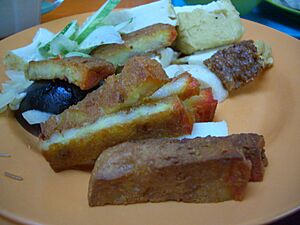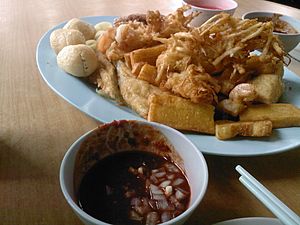Ngo hiang facts for kids
|
|
|
| Alternative names | Heh gerng (China); lor bak (Indonesia, Malaysia, Singapore); que-kiam, kikiam, kikyam, kekiam, ngohiong (Philippines) |
|---|---|
| Place of origin | Fujian, China |
| Region or state | Fujian, China; Hokkien-speaking areas; Indonesia, Malaysia, Philippines, Singapore, Thailand |
| Main ingredients | Various meats and vegetables, five spice powder, tofu skin |
| Ngo hiang | |||||||||||||
|---|---|---|---|---|---|---|---|---|---|---|---|---|---|
| Traditional Chinese | 五香 | ||||||||||||
| Simplified Chinese | 五香 | ||||||||||||
| Hokkien POJ | ngó͘-hiang | ||||||||||||
| Literal meaning | five spices | ||||||||||||
|
|||||||||||||
Ngo hiang (Chinese: 五香; Pe̍h-ōe-jī: ngó͘-hiang) is a tasty dish from China. It is also known by other names like heh gerng or lor bak. In the Philippines, it is often called kikiam. This dish is very popular in countries like Indonesia, Malaysia, the Philippines, Singapore, and Thailand. It comes from the Hokkien and Teochew cultures in southern China.
Ngo hiang is usually a roll made from different meats and vegetables. It often contains minced pork and shrimp, seasoned with a special mix of spices called five-spice powder. This mixture gives the dish its name, as "ngo hiang" means "five spices" in Hokkien. The seasoned meat is rolled inside a thin sheet of tofu skin and then deep-fried until it's crispy and golden.
This dish can also include other ingredients. You might find it with lup cheong, cucumber, century egg, ginger, deep-fried egg, or deep-fried tofu. Sometimes, fishballs are also part of the meal. Ngo hiang is typically served with a spicy chili sauce and a special sweet sauce.
Where to Find Ngo Hiang
In Singapore, many hawker centres and food courts sell ngo hiang. People often eat it with fried bee hoon (thin rice noodles) for breakfast or lunch. In Indonesia, people like to eat ngo hiang with a spicy paste called sambal.
Ngo Hiang in the Philippines
Hokkien people who moved to the Philippines brought this dish with them. There, it became known as kikiam. However, a version from Cebu called ngohiong is a bit different. Instead of using tofu skin, it is wrapped in lumpia wrappers. Lumpia wrappers are thin pastry sheets often used for spring rolls.
There is also a popular street food in the Philippines sometimes called "kikiam" or "tempura". This street food is actually an elongated version of fishballs. The street food version of kikiam is usually made from pork, not fish.
Gallery
-
Ngo hiang in Bogor, Indonesia
-
Street-food kikiam in Baliuag, Bulacan, Philippines
See also
 In Spanish: Quíquiam para niños
In Spanish: Quíquiam para niños






